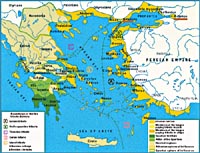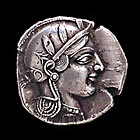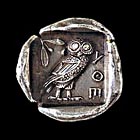

There were two characteristic features of the Athenian economy in the fifth and fourth centuries: 1) the traditional way of dealing with landed estates and farming was preserved, these being the most reliable sources of income; and 2) there was a spirit of adventure, as expressed via progress in trade and the development of a banking mechanism.
Tilling the land, trading voyages, and the slave trade,
together with tribute from the allies: all these
significantly strengthened both private property and the
coffers of the polis. |
 |
 |
 |
Athenians' relations with their state were marked by a tendency to mutual exploitation. Athens increased her revenues by a sophisticated tax system, and also by entrusting 'liturgies' (sponsorship) to citizens of means. The latter in turn undertook their obligations gladly, as a rule, though occasionally they would try and dodge them by concealing their estate. |
| a) | The 'liturgic' class. This consisted of 300 or so persons (fewer no doubt in the opening decades of the fourth century). The sources describe them as wealthy. The members of this class took the economic strain of the 'liturgies', and the estate of each was (in the fourth century at least) of the order of three to four talents. |
| b) | The propertied class. This was made up of 1,200 men whose estate came to not more than one talent. |
| c) | Payers of eisphora (property-tax). At the end of the fourth century these were, it has been calculated, not more than 6000 or so citizens. The estate of each was valued at not less than 2,500 drachmae. |
| d) | The hoplite class. This was composed of the citizen infantry, who numbered about nine thousand by the end of the fourth century and whose estate was in excess of 2,000 drachmae. |
| e) | The thetes class. At the end of the fourth century about 11,000 men, with an estate of less than 2,000 drachmae. |
| f) | Finally, those whom our sources describe as poor, meaning penniless. |
Below is a short description of some aspects of Athenian economic life, based partly on the works of Thucydides, Xenophon and Aristotle, but mainly on surviving speeches and inscriptions.
| Subdivisions of the Athenian coinage: | 6 obols = 1 drachma |
| 100 drachmae = 1 mna | |
| 60 mnae = 1 talent = 6.000 drachmae |
 |
| | introduction | landowning-farming | trade | mines | | |||
| | state welfare | liturgies | private property | | |||
| |||